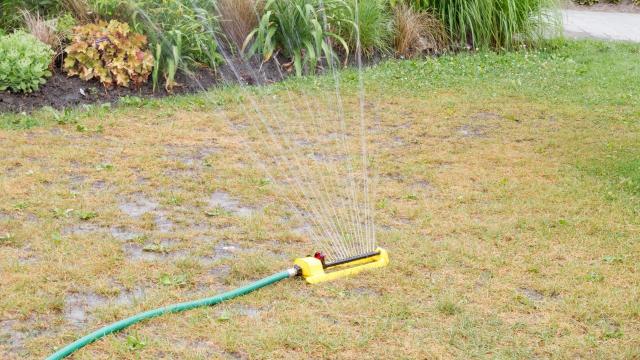The summer months are synonymous with dry, brown, crackling grass — a nightmare for those who love their luscious green lawns, and validation to those who think lawns are bullshit.
When it’s hot outside, your first instinct may be to dump excessive amounts of water onto your lawn, but a brown patch doesn’t necessarily mean a dead lawn. And while watering can help revive it, you’re probably using more than the lawn really needs. In a world where water is not an infinite resource, using less on your lawn is not only environmentally friendly, it actually keeps your grass healthier. Here is what you need to know to ensure you’re not overwatering your lawn this summer.
Use a screwdriver to know when to water your lawn this summer
How often you water your lawn depends on what type of grass you have, where you live, and your area’s rainfall. Generally, lawns need 2.5–3.5 cm of water each week, and watering once a week will meet this requirement, though you may need to water twice a week during dry summer months.
This doesn’t mean you should blindly water your lawn twice a week in the summer. Treat it like any other plant you want to keep alive and check your moisture levels regularly. To do so, you can buy a moisture metre, which sticks directly into your lawn and will give you an accurate reading.
If that’s more information than you really want, you can try the screwdriver technique. California Water News Daily instructs homeowners to, “stick an eight-inch screwdriver into the soil. If you can push it in more than three inches below the surface, you don’t need to water.”
How to help your lawn retain water in summer
Grass is a resilient plant. Its long blades convert sunlight into energy and collect rainwater. As owner of Gardening Express Chris Bonnett told Express, “[g]rass is clever enough to move any water and nutrients it is storing in its blades into the roots underground, as the temperature is cooler and there are no drying winds.” In addition, different types of grass and soil retain water more than others. The science-based gardening site Bio Advanced explains, “[a] healthy lawn of Tall Fescue has a deep root system and the highest drought tolerance.”
A deep root system increases the chances of your grass’s survival by trapping more water in its soil, and there are better ways to improve the health of your soil than overwatering. Molloy College found that letting your grass grow a bit higher can promote deep root growth — and the longer the roots, the better the water retention. To keep your lawn healthy, they recommend not taking any more than a third of the full blade off the top when mowing. Adding compost will also improve your soil and encourage root growth.
How to hydrate your lawn while conserving water
Water is a precious resource, and although we have easy and consistent access to it across most of the country, that doesn’t mean wasting it has no environmental impact. Fortunately, there are ways to save water and save your lawn. Many rural areas reduce water waste with the aid of water tanks or cisterns, underground tanks that holds rainwater for later use. Cisterns are an ancient water conservation method that predates modern plumbing, and still make sense today. Installing one can run you about $1 per litre it can hold. An underground cistern is an admittedly expensive way to water your lawn, but can serve more than your landscaping needs. According to Hunker, a 7,500 L cistern could provide a family of four enough water for several months, which may make them a smart investment for residents in drought-prone areas.
An easier option is to buy a rain barrel. When placed under your home’s rain gutters, a rain barrel will catch and hold the water for use on those dry days. It’s best to install one before the rainy season, and if you have the room, you can link together more than one using a hose, allowing you to stockpile more water to keep your lawn looking green. Elevate the barrel(s) on cinder blocks or pallets and install a spigot to attach a hose for easier watering.

Leave a Reply
You must be logged in to post a comment.